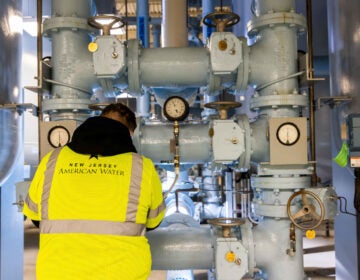Two more wells show possible PFAS contamination near Dover Air Force Base
Preliminary results show elevated levels of the so-called “forever chemicals” PFOS and PFOA near the installation in Delaware.

Wind-blown clumps of fire-suppression foam hang in the air outside of hangar 706 while the tail of a massive C-5M Super Galaxy can be seen inside the hangar at Dover Air Force Base, Del. (U.S. Air Force photo/Greg L. Davis)
The U.S. Air Force is still waiting for final confirmation, but preliminary tests show possible elevated levels of perfluorooctane sulfonate, or PFOS, and perfluorooctanoic acid, or PFOA, in a pair of wells near Dover Air Force Base. A final determination of the contamination is expected within 30 days.
The chemicals are part of a toxic class known as PFAS that include thousands of compounds used to make everything from nonstick cookware to water- and stain-resistant clothing.
In July, four wells east of the Delaware base were found to have elevated levels of PFOS and PFOA. Those four wells provide water to five businesses in a shopping center, plus two homes and an office building.
The two newly discovered wells provide water to a pair of commercial businesses. Both companies have been notified and, just like the residents and businesses affected by the contamination last summer, those businesses are getting bottled water supplied by the Dover base.
The state has not identified any of the businesses or residents that are affected.
Last year, the Air Force sampled groundwater from shallow monitoring wells on the base and found PFOS and PFOA levels there were also above the Environmental Protection Agency’s standard of 70 parts per trillion.
No PFAS contamination has been detected in five municipal wells that provide water to the base via Tidewater Utilities. State environmental officials say those wells draw from a “deep, confined aquifer.”
The contamination near the Dover air base and similar facilities in Pennsylvania is believed to be connected to the use of firefighting foam. PFAS chemicals can enter the bloodstream through contaminated drinking water. Once in the body, they have been linked to a range of health problems, such as certain cancers, thyroid dysfunction, and elevated cholesterol. They can also suppress a person’s immune system.
PFAS are known as “forever chemicals” because they do not break down naturally in the environment. Earlier this year, the Environmental Working Group issued a report claiming PFAS contamination in drinking water is far more prevalent than previously reported.
The EPA is funding research into ways to mitigate the danger PFAS contamination poses to public health.
In August, Framergy, which is incorporated in Delaware, won a $100,000 research grant to explore the use of metal-organic frameworks, or MOFs, to contain PFAS. The company is currently working on understanding how wastewater is collected and deposited in the soil so it can develop an engineering solution to apply its chemistry to actually doing the work of removing PFAS chemicals.
Framergy is testing the technology at the Firefighter Recruit Academy in College Station, Texas. It hopes to secure another grant worth $300,000 to continue the research this year.
WHYY is your source for fact-based, in-depth journalism and information. As a nonprofit organization, we rely on financial support from readers like you. Please give today.





